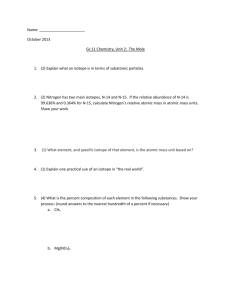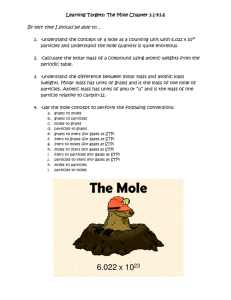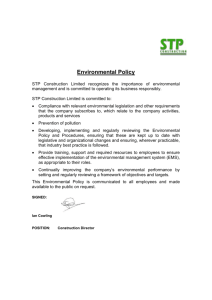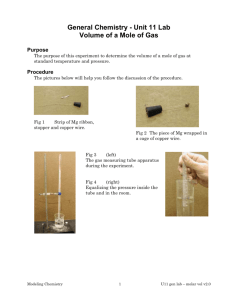Segment-5 Standard Molar Gas Volume & Density
advertisement
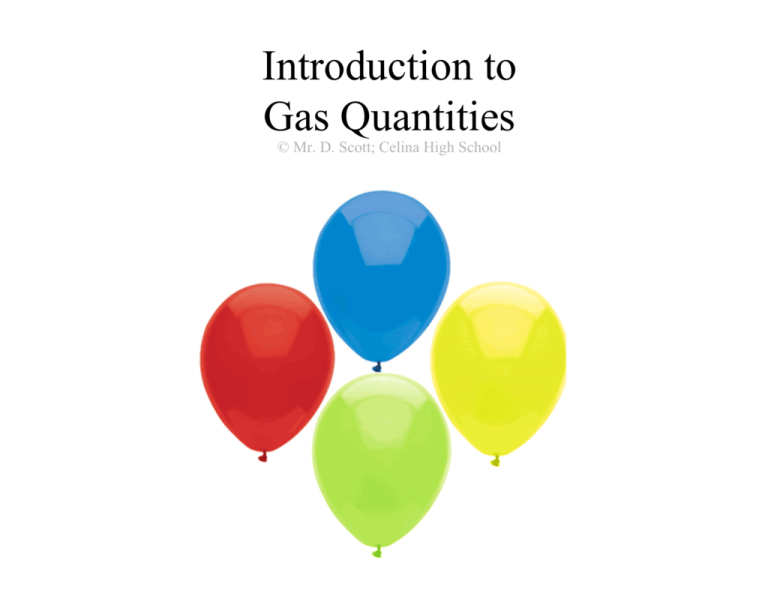
Introduction to Gas Quantities © Mr. D. Scott; Celina High School Everyone has seen hot air balloons floating in the sky. How do they work? By examining how a hot air balloon works, we can learn most of the basics about gases and how they work. The Main Parts: Obviously the “hot” in “hot air balloon” is a key part of how they work. The temperature of the air inside must be higher than the outside air. Consequently, the balloons must have a heat source. Propane burners are used for this purpose. Gas variables: •Temperature (T) •Volume (V) •Pressure (P) Tinside>Toutside Pinside=Poutside •Number of gas particles (n) Hot air balloons are open at the bottom Air particles are free to move in and out of the balloon in order to maintain and equal pressure with the surrounding air. Gas Particles in motion When heated, the gas particles move faster and bounce farther apart. With greater distances between the particles, some of them must exit the fixed volume of the balloon. Number of particles inside per liter Number of particles outside per liter The number of particles relates to the mass of the gas inside the balloon. Density = mass volume So, the density inside is LESS than the density outside. Buoyancy Air Density is LOWER Air Density is HIGHER The upward force that keeps things afloat. The net upward buoyancy force is equal to the magnitude of the weight of air displaced by the balloon. Denser, heavier air pushes the balloon up and out of its way. Examining the Gas Variables (T) Temperature = a measure that is proportional to the average kinetic energy of the particles in a sample of matter. KE 12 mv2 m mass v velocity Units: Celsius & Kelvin Kelvin=Celsius + 273.15 Celsius = Kelvin – 273.15 For a given particle, higher T means it is faster moving. But, when comparing two different particles, it may not. Let’s see how. Consider two particles at the same temperature: KE = KE If they are at the same T, then their KE is equal. 1 mv2 2 = 1 mv2 2 For two particles that have the same mass, equal changes in their temperature will result in equal changes in their velocity. Now, consider two particles at the same temperature that have different masses. = KE KE If they are at the same T, then their KE is still equal. 1 mv2 2 = 1 mv2 2 With different masses however, equal changes in their temperature will result in un-equal changes in their velocity. 1 2 m v2 = v 1m 2 2 The smaller particle must move faster to have the same KE as the larger one. Examining the Gas Variables (P) Pressure = the force exerted by the particles as they collide with the walls of their container. P F A The Mercury Barometer F force A area Vacuum space Height measured in millimeters Glass tube Liquid Hg Evangelista Torricelli is credited with inventing the barometer in 1643 Units: atmospheres, Pascals, bars, Torr, mmHg, psi 1.00 atm = 101325 Pa = 1.01325 bar = 760 Torr = 760 mmHg = 14.696 psi Examining the Gas Variables (V) Volume = the space available for the moving gas particles inside their container. Gas volume is measured in Liters. (n) Number of gas particles = the total number of individual gas molecules, atoms, or ions expressed in moles. Putting it all together For any given gas trapped in a container: PV =constant nT All four of these variables can be changing whenever chemical changes are happening. In order to keep things simple, we will first look at gas relationships between only (n) and (V). (n) And (V) can be examined for their relationship alone only when (T) and (P) are held constant. STP Standard Temperature and Pressure Standard Temperature = 0.00°C = 273K Standard Pressure = 1.00 atm = 760 mmHg (Torr) This now allows us to discover Avogadro’s Principle. Equal volumes of gas at the same temperature and pressure have equal numbers of particles regardless of the type of gases. In other words, at STP, one mole of gas will occupy a definite predictable volume. By setting our standard quantity at 1.00 mole of gas particles, the volume they occupy at STP turns out to be 22.4 Liters. Standard Molar Volume MOLE 22.4 liters 1 mol X mol 22.4L L 1mol 1mol mol X L 22.4 L Gas Volume at STP (L) Let’s do some conversions. MOLE X mol 22.4L L 1mol 1mol mol X L 22.4 L What volume would 1.75 moles of hydrogen gas occupy at STP? 1.75mol H2 Gas Volume 22.4 L 1 mol = 39.2 L H2 at STP (L) 15.0L of oxygen gas at STP consists of what number of moles? 15.0 L O2 1 mol 22.4 L = 0.670mol O2 Gas Density at STP Density = mass volume Gas density can change by changing the volume of the container while maintaining the same number of gas particles. Gas Density at STP Density = mass volume Gas density can also change by changing the number of particles while maintaining the same volume of the container. Gas Density at STP Density = mass volume Gas density is normally measured using grams for mass and liters for volume. Gas Density = grams = g L liters When the mass and volume are each known, the density can be solved directly by simply dividing. Example: What is the density of 2.00 g of CO2 that occupy 1.05 L? 2.00g CO2 D m 1.90 g L V 1.05L CO2 Gas Density at STP Knowing the identity of a gas at STP also allows us to find its density. Here’s how: Example: What is the density of nitrogen gas at STP? From STP we know: 22.4 L 1 mole From molar mass we know: And, we know that g L density must be Putting them together: g 1mol g 1mol 22.4L L 1 mole N2 28.0134 g N2 So we have: 28.0134 g N2 1 mole 1.25 g L 1 mole N2 22.4 L Gas Density at STP Using the density of a gas at STP, we can determine a molar mass. Here’s how: Example: A certain noble gas has a density of 3.74 g/L at STP. Which one is it? Since we are at STP we know: 22.4 L Having the density given we also know: 3.74 g 1 Liter 1 mole Making the units cancel to give us molar mass we have: 3.74 g 22.4 L = g 1 Liter 1 mol 1 mol Carrying out the arithmetic we have: 83.8 g The noble gas is: mol Krypton

